Why Your Body is Smarter Than the Fastest Computer
Imagine you’re playing football and the ball suddenly flies toward your face. In less than a second, your eyes detect the ball, your brain processes this threat, and your hands shoot up to protect you. All of this happens faster than you can consciously think about it! This incredible feat is what we call coordination and response – your body’s sophisticated communication system that keeps you alive and thriving every single second.
Unlike your phone that needs you to unlock it and tap buttons, your body is constantly monitoring, adjusting, and responding to changes without you even realizing it. From maintaining your body temperature on a freezing day to making your heart race when you’re nervous before an exam, these responses are orchestrated by two remarkable systems working in perfect harmony: the nervous system and the endocrine system.
In this comprehensive guide, we’ll unlock the secrets of Topic 14 and discover how your body coordinates millions of activities simultaneously. Whether you’re aiming for an A* or just trying to understand why you jump when someone scares you, this guide has got you covered!
What is Coordination and Response?
Coordination is your body’s ability to detect changes (called stimuli) in the environment and respond appropriately to maintain optimal conditions for survival.
Think of your body as a massive company with billions of employees (cells). For this company to succeed, everyone needs to communicate effectively and work together. That’s exactly what coordination does – it ensures all your organs, tissues, and cells work as one unified team.
The Basic Response Pathway
Every response in your body follows this simple sequence:
STIMULUS → RECEPTOR → COORDINATOR → EFFECTOR → RESPONSE
Let’s break this down with a real example:
- Stimulus: You touch a hot stove (heat)
- Receptor: Temperature sensors in your skin detect the heat
- Coordinator: Your brain or spinal cord processes this information
- Effector: Your arm muscles receive instructions
- Response: You pull your hand away quickly
This pathway is the foundation of all coordination in your body, whether it’s a split-second reflex or a carefully planned movement.
The Nervous System: Your Body’s High-Speed Internet
The nervous system is like a super-fast internet network running through your entire body, transmitting electrical signals at speeds up to 120 meters per second! It’s responsible for rapid, precise, and short-lived responses.
Structure of the Nervous System
The nervous system has two main divisions:
1. Central Nervous System (CNS)
- Brain: The command center that processes information and makes decisions
- Spinal Cord: The information superhighway connecting your brain to the rest of your body
2. Peripheral Nervous System (PNS)
- Sensory Neurons: Carry information FROM receptors TO the CNS
- Motor Neurons: Carry instructions FROM the CNS TO effectors (muscles or glands)
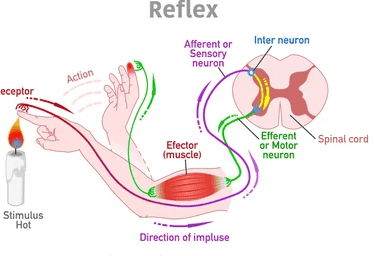
Meet the Neuron: The Messenger Cell
Neurons are specialized cells designed for one purpose: transmitting electrical signals called nerve impulses. They have a unique structure perfectly adapted for this job:
Key Parts of a Neuron:
- Cell Body: Contains the nucleus and controls the cell’s activities
- Dendrites: Short, branched extensions that receive signals from other neurons
- Axon: A long, thin fiber that carries impulses away from the cell body
- Myelin Sheath: A fatty insulating layer that speeds up impulse transmission (like insulation on electrical wires!)
- Nerve Endings: Tiny branches at the end of the axon that pass signals to the next cell
Memory Tip: Think of a neuron as a one-way street. Signals enter through dendrites (RECEIVE), travel through the cell body, and exit via the axon (TRANSMIT). The direction is always: Dendrite → Cell Body → Axon → Nerve Endings.
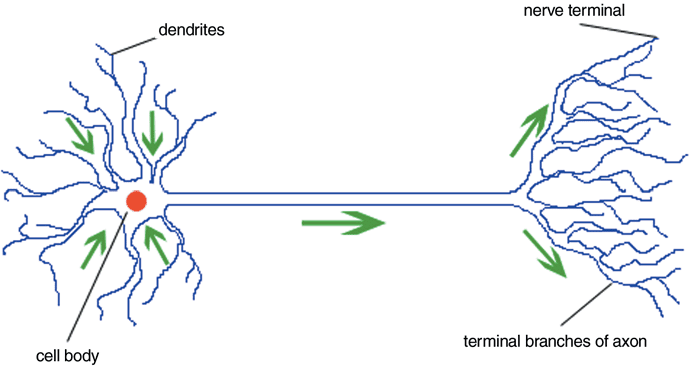
Types of Neurons
- Sensory Neurons: Have long dendrites and short axons; carry impulses from receptors to CNS
- Motor Neurons: Have short dendrites and long axons; carry impulses from CNS to effectors
- Relay Neurons (Interneurons): Connect sensory and motor neurons within the CNS; have short dendrites and axons
The Synapse: Bridging the Gap
Neurons don’t actually touch each other! There’s a tiny gap called a synapse between them. So how does the signal cross this gap?
How Synaptic Transmission Works:
- Electrical impulse arrives at the end of the first neuron
- This triggers the release of chemical messengers called neurotransmitters
- Neurotransmitters diffuse across the synaptic gap (about 20 nanometers wide)
- They bind to receptor proteins on the next neuron
- This binding triggers a new electrical impulse in the second neuron
Why have synapses?
- Ensures signals only travel in ONE direction
- Allows the nervous system to filter out weak or unimportant signals
- Enables one neuron to communicate with multiple neurons simultaneously
- Provides points where drugs or toxins can affect nerve transmission
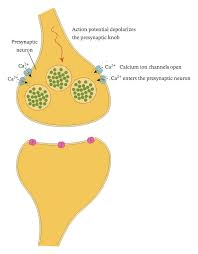
Reflex Actions: Your Body’s Emergency Response System
Have you ever wondered why you blink when something comes near your eye, or why your leg kicks when the doctor taps your knee? These are reflex actions – rapid, automatic responses that protect you from harm.
What Makes Reflexes Special?
- Automatic: They happen without conscious thought
- Rapid: Much faster than voluntary responses
- Protective: They prevent injury to the body
- Involuntary: You can’t stop them even if you try
The Reflex Arc: The Fast Track
A reflex arc is the pathway taken by nerve impulses in a reflex action. It’s called an “arc” because the signal makes a curved path from receptor to effector without going to the brain first!
Components of a Reflex Arc:
- Receptor: Detects the stimulus (e.g., pain receptors in skin)
- Sensory Neuron: Carries impulse to spinal cord
- Relay Neuron: Connects sensory to motor neuron in spinal cord
- Motor Neuron: Carries impulse to effector
- Effector: Muscle or gland that produces the response
Classic Example: The Pain Withdrawal Reflex
You accidentally touch a sharp pin:
- Pain receptors in your finger detect the sharp stimulus
- Sensory neuron transmits impulse to spinal cord
- Relay neuron in spinal cord passes signal to motor neuron (bypassing the brain!)
- Motor neuron carries impulse to arm muscles
- Arm muscles contract and pull your hand away
Meanwhile, another impulse is sent to the brain so you become conscious of the pain, but this happens AFTER you’ve already moved your hand!
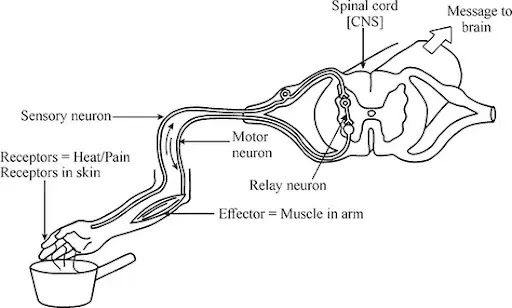
Conditioned Reflexes
Not all reflexes are inborn! Conditioned reflexes are learned through experience. The famous example is Pavlov’s dogs, who learned to salivate at the sound of a bell because they associated it with food. Similarly, you might feel hungry when you smell your favorite food, even if you weren’t hungry before!
Sense Organs: Your Windows to the World
Sense organs are specialized structures containing receptor cells that detect specific types of stimuli. Humans have five main sense organs:
| Sense Organ | Stimulus Detected | Type of Receptor |
|---|---|---|
| Eye | Light | Photoreceptors |
| Ear | Sound and balance | Mechanoreceptors |
| Nose | Chemicals in air | Chemoreceptors |
| Tongue | Chemicals in food | Chemoreceptors |
| Skin | Touch, pressure, temperature, pain | Various receptors |
Let’s focus on the most important one for your IGCSE exam: the eye.
The Eye: A Living Camera
Your eye is an incredible feat of biological engineering that works remarkably like a camera. It can adjust to different light conditions, focus on objects at varying distances, and detect millions of colors!
Structure and Function of the Eye
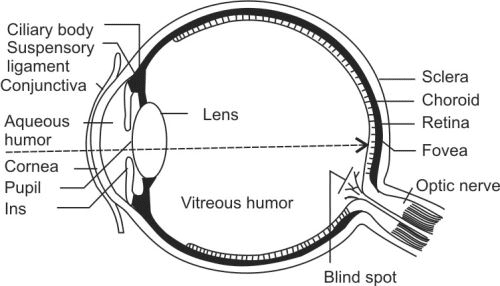
External Structures:
- Sclera (White of Eye): Tough, protective outer layer that maintains eye shape
- Cornea: Transparent front portion that refracts (bends) light entering the eye. Does most of the focusing!
- Conjunctiva: Thin membrane covering the front of the eye; keeps it moist
Light Control Structures:
- Iris: Colored, muscular ring that controls pupil size
- Pupil: Black circular opening in the center of the iris through which light enters (not actually a structure, just a hole!)
Focusing Structures:
- Lens: Transparent, elastic structure that fine-tunes focus by changing shape
- Ciliary Muscles: Ring of muscles that control lens shape
- Suspensory Ligaments: Connect the lens to ciliary muscles; hold lens in place
Light-Sensitive Structures:
- Retina: Light-sensitive inner lining containing photoreceptor cells
- Rods: Photoreceptors that detect light intensity (black and white vision); work in dim light
- Cones: Photoreceptors that detect color; work in bright light; concentrated at the fovea
- Fovea (Yellow Spot): Area of sharpest vision with the highest concentration of cones
- Blind Spot: Point where optic nerve leaves the eye; has no photoreceptors so can’t detect light
- Optic Nerve: Carries electrical impulses from retina to brain
Supporting Structures:
- Choroid: Middle layer containing blood vessels that supply the eye with oxygen and nutrients; black pigment prevents internal light reflection
How the Eye Focuses: Accommodation
Accommodation is the process by which the eye changes the shape of the lens to focus on objects at different distances.
Viewing DISTANT Objects (Far Accommodation):
- Ciliary muscles relax
- Suspensory ligaments are pulled tight
- Lens is pulled thin (less curved)
- Light is refracted less
- Image focuses on the retina
Viewing NEAR Objects (Near Accommodation):
- Ciliary muscles contract
- Suspensory ligaments become slack (loose)
- Lens becomes fat (more curved) due to its natural elasticity
- Light is refracted more
- Image focuses on the retina
Memory Tip: “Ciliary muscles Contract for Close objects” (all three C’s!)
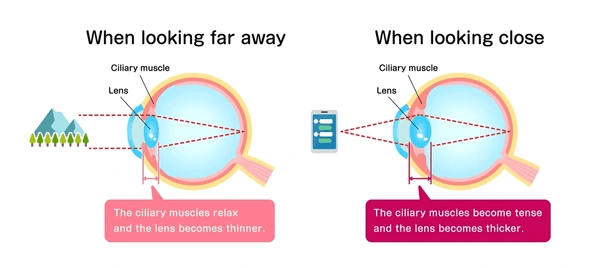
The Pupil Reflex: Controlling Light Intensity
The iris contains two types of muscles that control pupil size:
In BRIGHT Light:
- Circular muscles contract
- Radial muscles relax
- Pupil becomes smaller (constricts)
- Less light enters the eye
- Purpose: Protects the sensitive retina from damage
In DIM Light:
- Circular muscles relax
- Radial muscles contract
- Pupil becomes larger (dilates)
- More light enters the eye
- Purpose: Maximizes light entering for better vision

Table: Comparison of Rods and Cones
| Feature | Rods | Cones |
|---|---|---|
| Function | Detect light intensity | Detect color |
| Light Sensitivity | High (work in dim light) | Low (need bright light) |
| Location | Throughout retina, absent from fovea | Concentrated at fovea |
| Number in Eye | ~120 million | ~6 million |
| Visual Acuity | Low detail | High detail (sharp vision) |
| Color Detection | None (black & white only) | Three types (red, green, blue) |
The Endocrine System: Your Body’s Postal Service
While the nervous system is like email (fast and direct), the endocrine system is like traditional mail (slower but longer-lasting effects). It uses chemical messengers called hormones that travel through the bloodstream to target organs.
What Are Hormones?
Hormones are chemical substances produced by endocrine glands and transported in the blood. They regulate long-term processes like growth, metabolism, and reproduction.
Key Characteristics of Hormonal Control:
- Slower than nervous control (takes seconds to hours)
- Longer-lasting effects (hours to years)
- Transported via bloodstream
- Affects target organs/tissues that have specific receptor proteins
- Generally involves widespread effects throughout the body
Major Endocrine Glands and Their Hormones
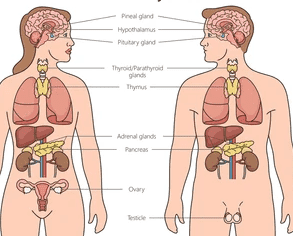
Table: Important Hormones for IGCSE
| Gland | Hormone | Target Organ | Main Function |
|---|---|---|---|
| Pancreas | Insulin | Liver, muscles | Decreases blood glucose (promotes glucose → glycogen) |
| Pancreas | Glucagon | Liver | Increases blood glucose (promotes glycogen → glucose) |
| Adrenal Glands | Adrenaline | Heart, lungs, muscles | Prepares body for “fight or flight” response |
| Pituitary | ADH (Antidiuretic Hormone) | Kidneys | Controls water reabsorption; regulates urine concentration |
| Testes | Testosterone | Various | Controls male secondary sexual characteristics |
| Ovaries | Oestrogen & Progesterone | Various | Control female secondary sexual characteristics and menstrual cycle |
Adrenaline: The “Fight or Flight” Hormone
When you’re scared, stressed, or excited, your adrenal glands release adrenaline. This hormone prepares your body for immediate action!
Effects of Adrenaline:
- Increases heart rate → pumps more blood to muscles
- Increases breathing rate → supplies more oxygen
- Converts glycogen to glucose in liver → provides instant energy
- Redirects blood flow from digestive system to muscles and brain
- Dilates pupils → improves vision
- Inhibits non-essential processes like digestion
Real-Life Example: Before your Biology exam, you might feel your heart racing, hands sweating, and butterflies in your stomach. That’s adrenaline preparing you to face the “threat” of the exam!
Homeostasis: Keeping Everything Just Right
Homeostasis is the maintenance of a constant internal environment despite changes in external conditions. It’s like having a thermostat that automatically adjusts your home’s temperature.
Why is Homeostasis Important?
Your cells can only function optimally within narrow ranges of conditions. For example:
- Temperature: Enzymes work best at 37°C; too hot or cold denatures them
- Blood glucose: Cells need steady glucose supply for respiration
- Water content: Too much or too little disrupts osmosis and cell function
- pH levels: Most enzymes work best around pH 7
Negative Feedback: The Master Control Mechanism
Negative feedback is the process that reverses changes and returns conditions to their set point. It works like this:
- Receptor detects a change from normal (e.g., blood glucose too high)
- Coordinator (brain or gland) processes this information
- Effector (organ or tissue) produces a response to reverse the change
- Condition returns to normal
- Correction mechanism switches off
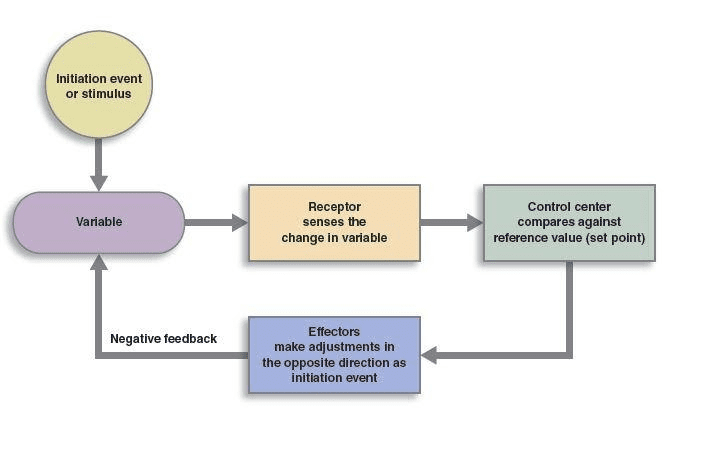
Blood Glucose Regulation: A Perfect Example of Homeostasis
Your blood glucose level must be kept relatively constant around 90 mg per 100 cm³ of blood. This is controlled by two hormones from the pancreas working as antagonists (opposites).
When Blood Glucose is TOO HIGH (after eating a meal):
- Pancreas detects high blood glucose
- Insulin is released from pancreas
- Insulin travels in blood to liver and muscles
- Liver converts glucose → glycogen (glycogenesis) for storage
- More glucose is taken up by body cells for respiration
- Blood glucose level decreases to normal
When Blood Glucose is TOO LOW (during exercise or fasting):
- Pancreas detects low blood glucose
- Glucagon is released from pancreas
- Glucagon travels in blood to liver
- Liver converts glycogen → glucose (glycogenolysis)
- Glucose is released into bloodstream
- Blood glucose level increases to normal
Memory Tip:
- Gluc-A-gon = Adds glucose (increases)
- Insulin = Into cells/storage (decreases)
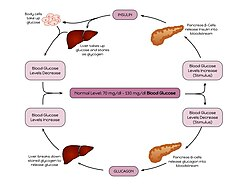
Diabetes: When Glucose Control Goes Wrong
Type 1 Diabetes:
- Pancreas produces insufficient insulin
- Blood glucose remains too high after meals
- Glucose appears in urine (normally absent)
- Treatment: Regular insulin injections, controlled carbohydrate diet, regular exercise
Type 2 Diabetes:
- Body cells become resistant to insulin
- More common in overweight, inactive individuals
- Treatment: Controlled diet, increased exercise, weight loss, medication (sometimes insulin)
Comparing Nervous and Endocrine Systems
Table: Nervous vs Endocrine Control
| Feature | Nervous System | Endocrine System |
|---|---|---|
| Signal Type | Electrical impulses | Chemical (hormones) |
| Speed | Very fast (milliseconds) | Slower (seconds to hours) |
| Duration | Short-lived | Long-lasting |
| Pathway | Neurons | Bloodstream |
| Target | Specific (muscles/glands) | Often widespread |
| Examples | Reflex actions, movement | Growth, metabolism, reproduction |
When to Use Which?
Think about the situation:
- Need to escape danger? → Nervous system (fast!)
- Need to grow taller? → Endocrine system (gradual, long-term)
- Need to regulate blood sugar after meals? → Endocrine system (sustained control)
- Need to pull hand away from heat? → Nervous system (immediate!)
Plant Responses: They’re Alive Too!
Plants may seem static, but they actually respond to their environment through growth movements called tropisms.
Types of Tropisms
- Phototropism: Response to light
- Shoots grow towards light (positive phototropism)
- Roots grow away from light (negative phototropism)
- Gravitropism (Geotropism): Response to gravity
- Roots grow downwards (positive gravitropism)
- Shoots grow upwards (negative gravitropism)
How Do Plants Do This? Plant Hormones!
Auxins are plant hormones that control growth responses:
- Produced in shoot and root tips
- Cause cell elongation in shoots
- Move away from light and towards gravity
- Accumulate on the shaded/lower side of the plant
Phototropism Explained:
- Light shines on one side of a shoot
- Auxin moves to the shaded side
- Cells on shaded side grow longer
- Shoot bends towards the light
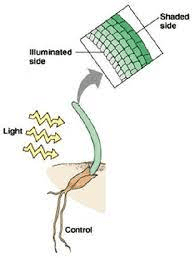
Why is this useful? Plants need light for photosynthesis, so growing towards light increases survival. Roots growing downwards helps anchor the plant and reach water!
KEY FORMULAS AND EQUATIONS BOX
While Topic 14 doesn’t have many mathematical equations, here are the key processes you must know:
Blood Glucose Regulation:
Glucose → Glycogen (storage) [Insulin promotes this]
Glycogen → Glucose (release) [Glucagon promotes this]Reflex Arc Pathway:
Stimulus → Receptor → Sensory Neuron → Relay Neuron (CNS) → Motor Neuron → Effector → ResponseResponse Coordination Pathway:
Stimulus → Receptor → Coordinator → Effector → ResponseSynaptic Transmission:
Electrical Impulse → Neurotransmitter Release → Diffusion across Synapse → New Electrical ImpulseQUICK REVISION NOTES
The Nervous System:
- CNS = Brain + Spinal Cord
- PNS = Sensory + Motor Neurons
- Neuron parts: Dendrites → Cell Body → Axon → Nerve Endings
- Synapse = gap between neurons; uses chemical neurotransmitters
- Reflex arc bypasses brain for rapid response
The Eye:
- Cornea does most focusing (refracts light)
- Lens fine-tunes focus (accommodation)
- Near: ciliary muscles CONTRACT, lens FAT
- Far: ciliary muscles RELAX, lens THIN
- Bright light: pupil SMALL (circular muscles contract)
- Dim light: pupil LARGE (radial muscles contract)
- Rods = dim light, no color
- Cones = bright light, color, concentrated at fovea
Hormones:
- Chemical messengers in blood
- Slower but longer-lasting than nerves
- Insulin DECREASES blood glucose
- Glucagon INCREASES blood glucose
- Adrenaline = “fight or flight” hormone
Homeostasis:
- Maintaining constant internal environment
- Negative feedback reverses changes
- Blood glucose controlled by insulin and glucagon (antagonistic)
Plant Responses:
- Tropisms = growth responses
- Phototropism = response to light
- Gravitropism = response to gravity
- Auxins control plant growth
COMMON MISTAKES TO AVOID
- Saying “reflex actions involve the brain”
- ✅ Correct: Reflex arcs go through spinal cord, bypassing the brain for speed
- Confusing which way neurons carry impulses
- ✅ Sensory = TO CNS; Motor = FROM CNS (think “Motor = Movement away”)
- Mixing up insulin and glucagon
- ✅ Remember: Insulin INto storage (decreases); Glucagon Adds glucose (increases)
- Saying the pupil is a structure
- ✅ Correct: The pupil is just a hole; the IRIS controls its size
- Forgetting that ciliary muscles CONTRACT for near objects
- ✅ Use the “3 C’s” memory tip: Ciliary Contract for Close
- Thinking hormones work faster than nerves
- ✅ Nerves = fast & short; Hormones = slow & long-lasting
- Saying rods detect color
- ✅ Correct: CONES detect Color (both start with C!)
- Forgetting negative feedback REVERSES changes
- ✅ It’s called “negative” because it negates/reverses the change
MEMORY TIPS & MNEMONICS
- Reflex Arc Pathway: “Some Really Stunning Red Motorbikes Excite Racers”
- Stimulus → Receptor → Sensory neuron → Relay neuron → Motor neuron → Effector → Response
- Accommodation: “Ciliary muscles Contract for Close objects”
- Types of Neurons: “Sensory neurons Send info To CNS; Motor neurons Move it Away”
- Insulin vs Glucagon:
- Insulin = Into storage (like putting money in the bank)
- Glucagon = Goes out (taking money out)
- Rods and Cones:
- Cones for Color
- Rods for Reduced light
- Hormone Transport: “Hormones Hitch a ride in the bloodHighway”
- Negative Feedback: Think “Negative = Negates the change”
REAL-LIFE CONNECTIONS
Medicine and Health:
- Diabetes treatment relies on understanding insulin and glucagon
- Laser eye surgery corrects focusing problems by reshaping the cornea
- Parkinson’s disease affects neurotransmitter production
- Local anesthetics block nerve impulse transmission at synapses
Sports and Athletics:
- Adrenaline gives you that performance boost before competition
- Reaction time tests measure nervous system speed
- Athletes train reflex responses to improve performance
Technology:
- Computer vision systems are inspired by the human eye
- Artificial neural networks in AI mimic real neurons
- Robotics uses feedback systems similar to homeostasis
- Touch screens detect pressure like your skin receptors
Everyday Life:
- Adjusting to darkness in a cinema (pupil dilation)
- Feeling hungry at regular meal times (conditioned response)
- Houseplants growing towards window light (phototropism)
- Blood sugar crashes making you irritable (glucose regulation)
FINAL THOUGHTS: YOU’VE GOT THIS!
Congratulations on making it through this comprehensive guide to Coordination and Response! This topic might seem challenging at first, but remember: your own body is demonstrating these concepts every single second. Every time you blink, breathe, or balance, you’re experiencing this beautiful coordination firsthand.
Key Takeaways to Remember:
✅ Your body has TWO coordination systems working together: fast nervous system and steady endocrine system
✅ Reflex actions protect you by bypassing the brain for speed
✅ The eye is an amazing camera that constantly adjusts to changing conditions
✅ Hormones are chemical messengers that control long-term processes
✅ Homeostasis keeps your internal environment stable through negative feedback
✅ Even plants respond to their environment through tropisms!
Remember, biology is not just about memorizing facts – it’s about understanding the incredible story of life. When you truly grasp how your body coordinates millions of responses every second to keep you alive and thriving, you’ll find that this knowledge sticks with you far beyond the exam hall.
You’re not just studying for a grade; you’re unlocking the secrets of your own existence. How amazing is that?
Recommended –

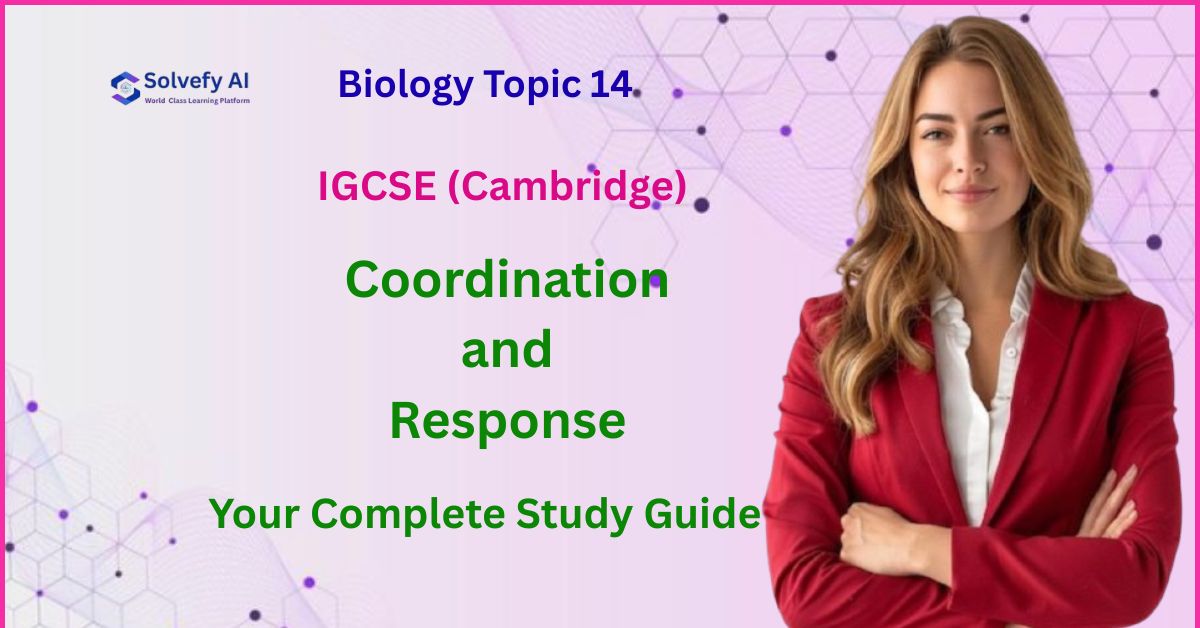
1 thought on “Coordination and Response | IGCSE Biology Topic 14 Complete Guide”